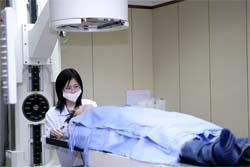This overview of endometrial cancer (also called womb cancer or uterine cancer) covers causes (from estrogen to pathogens), symptoms (from vaginal bleeding to discharge), diagnosis and all the latest treatment alternatives (from tamoxifen to natural therapies).
Endometrial, womb or uterine cancer
Here you will find cancer information, including all the latest cancer news on these cancers to help you increase your personal odds of survival - for example, the symptoms, the diagnosis and all the latest options on cancer treatments - from cancer drugs and chemotherapy to surgery, radiotherapy and complementary cancer therapies; including all the very latest alternative cancer treatments.
This article has been compiled by Chris Woollams from worldwide research and expert sources*
Read the whole article below or just select the part(s) that you are interested in from the list below and click onto that piece
The Womb, or Uterus

Endometrial cancer is a type of cancer that begins in the uterus. Where it is confined to the uterus, it is called Uterine or womb cancer. 75% of cancers are in the Uterus and are referred to as an Adenocarcinoma of the Uterus. If untreated it can spread to the bladder or rectum.
The womb is the organ of foetal care. It is a muscular organ with a lining called the endometrium. It is this lining that is shed monthly with periods. The vagina leads upwards to the cervix, the lower part of the womb.
 Want to receive the very latest information on this cancer? Click here
Want to receive the very latest information on this cancer? Click here
Cancers of the vagina and cervix are covered elsewhere on this Website, as is Ovarian cancer. This section just covers cancer that originates in the lining of the womb - Endometrial, uterine or womb cancer.
back to the top
The Causes of Endometrial cancer
This cancer, which affects approximately 9,500 women in the UK and 63,200 women in the USA each year is growing rapidly. It is now the fourth most common female cancer after breast, colon, and lung cancers. The incidence amongst women 60-79 years of age has risen by 35 per cent in less than a decade. 90 per cent of all cases occur in women over 50 years of age, and 75 per cent in women who have been through the menopause. However, there is a genetic factor involved in some instances and in this case the cancer can strike at any age.
Early diagnosis is important but also very common, since vaginal bleeding in post-menopausal women is an early sign. Overall 5-year survival rates are 77 per cent but they have improved by only 16 per cent in the last 30 years. If the cancer is diagnosed late, the 5-year survival figure falls to 25 per cent (CRUK icon 1; 2006)
For older women, increased risk has been linked to:
1. Oestrogen or Estrogen. There is increasing evidence pointing a finger at oestrogen, including the synthetic version. Risk factors seem to include never having been pregnant, starting periods at a very young age, finishing periods at an older age, irregular ovulation and taking synthetic oestrogen in HRT, especially for more than 5 years.
2. Tamoxifen - There is research by O. LAVIE, O. BARNETT-GRINESS, S.A. NAROD, G. RENNERT in a paper entitled 'The risk of developing uterine sarcoma after tamoxifen use' (International Journal of Gynecological Cancer (OnlineEarly Articles):doi:10.1111/j.1525-1438.2007.01025.). The researchers studied the history of Breast cancer patients, and followed whether they had used Tamoxifen or not. They then compared the 875 women who had used Tamoxifen with those who had not. In conclusion they stated, "There were 17 uterine cancers observed among the 875 exposed to tamoxifen compared to 4 uterine cancers among the 621 women who did not use tamoxifen. There were four uterine sarcomas among the tamoxifen users, but none among nonusers. Five of the 875 tamoxifen users died of uterine cancer, compared to no deaths among nonusers. We conclude that in this national breast cancer cohort, tamoxifen use was associated with elevated risks of uterine cancer incidence and mortality. Uterine sarcomas appear to be overrepresented among women who use tamoxifen."
3. Being overweight - In the European Prospective Investigation into Cancer and Nutrition (EPIC) 2007, obesity, abdominal fat and adult weight gain were shown to have a strong link to endometrial cancer. Risk more than doubles where a woman has gained more than 44 pounds since the age of 20. Women with a waist of over 34 inches have double the risk of women with a waist less than 31 inches.
This cancer has also been linked to higher consumption of fizzy soft drinks (sodas).
CRUK have stated that they believe this is due to higher estrogen levels being made in the fat stores.

Go to: 10 ways to reduce your estrogen naturally
Natural progesterone has proven to be a significant aid with the disease; it balances oestrogen levels in younger women but the hormone declines significantly after the menopause.
Losing weight, using Indole 3 carbinol, taking 20 mg of melatonin before bed, eating phytoestrogens like pulses and beans, and avoiding pesticides, herbicides, fungicides and cleaning up your home and your toiletry and personal care products is a start.
Go to: As Safe as Houses
Patients with this cancer are recommended to read our short book Oestrogen the killer in our midst which details various ways of reducing or balancing this dangerous hormone in full.

Endometrial cancer is itself slow growing and takes a number of years to develop; it is often caught at an early stage because of vaginal bleeding.
4. Bacterial Infection - The bacteria found in the womb and vagina of women with the disease differ from those of women who are healthy. There seems to be a loss of commensal bacteria (good bacteria) in terms of strains and volume, but an increase in pathogens. According to Japanese researchers, Enterobacteriaceae, Streptococcus agalactiae and anaerobic bacteria are abundant in the uterus of women with Endometrial cancer. E.coli is known to be linked to UTIs and bladder cancer, but higher levels have also been found in colorectal and breast cancer.
Researchers at the Mayo clinic looked at the microbial populations of the cervix, vagina, uterus, Fallopian tubes and ovaries, comparing healthy women with those having endometrial cancer. They found that women with cancer or pre-cancer had significantly higher levels of Atopobium vaginae and Porhyromonas species. Scientists now believe such pathogens can cause inflammation in the womb and even change DNA structure.
Pathogens have also been found in the fallopian tubes and ovaries. Natural herbs such as Artemisia and its bioactive ingredient artemisinin can play a role in defeating such infections.
An important part of any treatment program should include tackling such pathogens, yeasts and even parasites.
Chris Woollams builds programs for people who are confused about what to do to increase their personal odds of survival:
Go to: What people say about a Personal Prescription with Chris Woollams
Endometrial cancer is very beatable if tackled early and/or thoroughly.
5. Diabetes, high blood pressure - There is also a higher risk of endometrial cancer in women with diabetes or higher blood pressure.
6. Heavy metals - womb cancer has been linked to higher levels of cadmium in the body according to researchers from the University of Missouri Medical School in 2017
7. Uterine Polyps - polyps can appear in the womb. They can vary in size - from the size of a grain of rice to that of a golf ball. They are more common as you age, and can be easily treated. It is believed that they do not lead to Uterine cancer, but the evidence is inconclusive as yet. They are caused by an overgrowth of the lining of the womb.
back to the top
Symptoms of Endometrial cancer
The most common symptoms are:
-
Abnormal bleeding for example between periods, or especially post-menopause after periods have ceased.
-
Pain in lower abdomen and pelvis.
-
Vaginal discharge.
back to the top
Diagnosis of Endometrial cancer
A thin tube with a light at the end, called a hysteroscope, may be inserted up the vagina. The doctor may at the same time take some samples of cells (this is called a biopsy). No anesthetic is needed.
An Ultrasound, (rather as with a pregnancy), can be useful a metal rod connected to a TV screen emits radio waves into the womb area and depending upon their absorption or reflection, a simple picture is formed. This is an external test and is painless.
back to the top
Stage and Grade of Endometrial cancer
Stage measures the spread of the cancer; grade measures the aggression.
Stage 1 means that the cancer is confirmed to the lining and the muscle wall.
Stage 2 means it has spread to the cervix.
Stage 3 means it has spread into the ovaries or abdomen. It may have spread to adjacent lymph nodes.
Stage 4 Means it has spread to other parts of the body like the bowel, brain, bones or lungs.
back to the top
Treatment alternatives for Endometrial cancer
Surgery: is the primary treatment for endometrial cancer. Encouragingly, most womb cancers are discovered early and surgery (a hysterectomy to remove the womb, or one that also removes fallopian tubes and ovaries as well) is very effective. Lymph nodes may also be removed at the same time. This is however a major operation but it seems to be successful in most cases.
 Radiotherapy: may be used to kill off any remaining cancer cells, but there is a realistic fear of long-term damage from the beam on adjacent organs especially the bladder or bowel. Readers might like to read 20 things you should know about Radiotherapy.
Radiotherapy: may be used to kill off any remaining cancer cells, but there is a realistic fear of long-term damage from the beam on adjacent organs especially the bladder or bowel. Readers might like to read 20 things you should know about Radiotherapy.
Radiotherapy may also be used to shrink the tumour prior to surgery.
Radiotherapy can be normal external radiotherapy or more commonly internal radiotherapy, or brachytherapy (the use of radioactive seeds). In internal radiotherapy an applicator (a metal rod with radioactivity) is inserted much as a tampon would be. It can cause severe bleeding.
The text books say that this method gives a high dose of radiotherapy to the local cancer cells, but negligible amounts to the organs further away. However, those same books and leaflets talk about risks to visitors and how children are not even allowed in the same room on occasion!
Ask. And obtain the full details to the point where you are happy that you fully understand the benefits and risks.
Hormone Therapy: In the USA synthetic progestin is often used as Hormone Therapy Treatment. It may have side effects but does help significantly. Readers might also look into Natural Progesterone Therapy which can be equally effective with less side-effects. Where the ovaries remain, Luteinising agents are used such as Zolodex and Lupron. Increasing breast cancer drugs are used; for example, one used to block oestrogen action - Tamoxifen; or Aromatase Inhibitors such as Arimidex, Anastrozole, Letrazole are used to block the production of estradiol in the fat stores by aromatase enzymes.
Natural compounds such as Indole 3 carbinol, melatonin, and the Chinese herbal complex Myomin are increasingly employed by women trying to empower themselves; they also consume large amounts of phytoestrogens. Some use Red Clover with its active ingredient genestein. White button mushrooms contain aromatase inhibitors.
Chemotherapy: may be used where there is spread. The most common drugs are carboplatin, paclitaxel (taxol), doxorubicin (adriamycin) or the liposomal version Doxil and cisplatin. The following may sometimes be used: mitomycin, chloroambucil, vinblastine and methotrexate. All are bog-standard chemo drugs. For information on your Cancer Drugs and chemotherapy click here.
Go to: Ten ways to improve your chemotherapy and reduce side-effects
Immunotherapy - Clinical trials are underway on the use of Pembrolizumab (Keytruda) with endometrial cancer.
Repurposed drugs - several drugs not originally intended for use with cancer may help. For example, metformin. It seems able to both cut blood sugar and thus inhibit cancer cell growth, but also inhibit energy production pathways, in one research study. The natural herbal extract Berberine has research showing it has similar action to metformin, and it is also an anti-inflammatory compound. Berberine both suppresses growth and metastasis of endometrial cancer.
back to the top
Understanding your doctor
 Click here and read our article "What is Cancer"
Click here and read our article "What is Cancer"
Although we always try to write in easy-to-understand words, you may find that some web sites, information leaflets, Doctors and Nurses use words that are not as easy to understand. For that reason we have compiled a list of all the technical words they commonly use called DOCTORSPEAK, the list turns it all into simple, easy to understand English. You can find this list of words by clicking here.
back to the top
Complementary and alternative Endometrial Cancer Treatments
CANCERactive is Europe's Number 1 Integrative Cancer Charity. This website alone has more than 4,000 pages of information on it, either as articles or as news stories. More than 10,000 people visit our websites every day. We know from the feed-back we receive just how much we are valued by people trying to beat cancer.
We believe you can increase your personal odds of cancer survival by taking simple health-enhancing steps and adding both complementary cancer therapies and alternative cancer therapies into your mix of treatments.
For example, Hyperbaric Oxygen, curcumin, calorie restriction, melatonin, probiotics and whole body hyperthermia have all been shown in research to make chemotherapy work better. It then kills more cells! The research is covered on this website. Surely it makes a lot of sense to use them in your personal cancer treatment programme?
Go to: How to improve your chemotherapy
We cover how to improve your radiotherapy (and reduce side-effects) too.
Go to: Improve your Radiotherapy, and reduce side-effects
We have a complete review of Immunotherapy telling you the accurate figures and what to watch out for. We tell you what is working and when two new drugs have been used, rather than one. Its a new, emerging and alternative cancer therapy, but not fully there yet!
Then we have an article on how to improve the success of your radiotherapy (and reduce the potential side-effects) all by adding complementary therapies. Our Guidelines on Diet and Exercise can be found through this link:
Go to: CANCERactive Guidelines on Diet and exercise
Our recommended anti-cancer diet is the colourful Mediterranean Diet (with its focus on the French paradox):
Go to: The Rainbow Diet
Like Hippocrates, we believe all cancer begins in the gut and that gut problems, yeast, viral and parasite infections are common constituents of cancer.
Go to: All cancer begins in the gut
But if you just want to look at the most comprehensive list of Complementary Therapies you can find it here:
Go to: CANCERactive Complementary and Integrative cancer therapies
And if you want alternative cancer therapies start here:
Go to: CANCERactive Alternative cancer therapies
Finally, if you want all this put together for you in one simple plan, why not look into having a Personal Prescription?
Go to: Personal Prescriptions with Chris Woollams
We don't take one penny from any Pharmaceutical company, cancer clinic or supplements company. We have no vested interest. We just want to see you beat cancer.
"If you are already thinking of supplementing with any of the above products, why not take a look at OurNatural Selection by clicking here."
back to the top
Overall
On this Website you will find more information about more treatment options (Complementary and Alternative, not just Orthodox), and on more possible contributory factors to the development and maintenance of your cancer, than on any other UK cancer Website. Some experts believe that approaching your cancer in this 'total' or holistic, or Integrative' way can increase an individual's chances of survival by as much as 60 per cent.
This is all supported by the very latest research evidence from all over the world in our news section Cancer Watch.
We can do this because we are not hide-bound by vested interests, and so we can always put people first. We are not influenced by companies who seek to make financial gains from patients, we have no trustees working for, or sponsored directly or indirectly by such companies, our directors take no remuneration at all. This is our true independence, from which you benefit directly.
But this independence comes at a price: We can only rely on you, and people like you, to support our work. 2 million people visited our site in 2016, viewing 11 pages on average. Every month we add 20 new pages to this site. The letters and e mails of gratitude and praise tell us we really do make a difference.
If you feel an independent voice is essential in cancer, please, please help by making a donation. Every little helps.
back to the top
The CANCERactive Difference: Intelligent Information. Independent Voice.
IMPORTANT INFORMATION
|
* Cancer (and its related illnesses) are very serious and very individual diseases. Readers must always consult directly with experts and specialists in the appropriate medical field before taking, or refraining from taking, any specific action.
This web site is intended to provide research-based information on cancer and its possible causes and therapies, so that you can make more informed decisions in consultation with those experts. Although our information comes from expert sources, and is most usually provided by Professors, scientists and Doctors, our easy-to-understand, jargon-free approach necessitates that journalists, not doctors, write the copy. For this reason, whilst the authors, management and staff of CANCERactive, icon, and Health Issues have made every effort to ensure its accuracy, we assume no responsibility for any error, any omission or any consequences of an error or omission. Readers must consult directly with their personal specialists and advisors, and we cannot be held responsible for any action, or inaction, taken by readers as a result of information contained on this web site, or in any of our publications. Any action taken or refrained from by a reader is taken entirely at the readers own instigation and, thus, own risk.
|